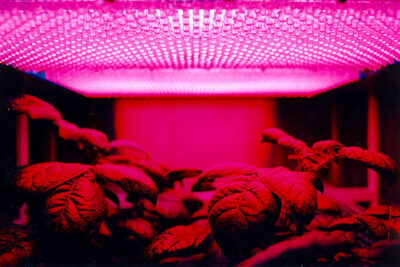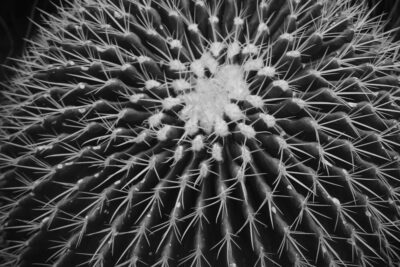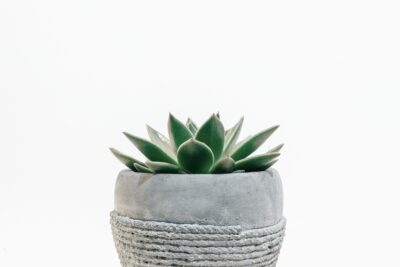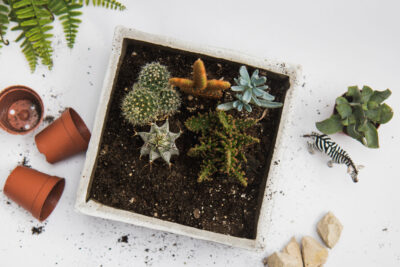
Succulents: Perennials or One-Season Wonders? Unveiling their Lifespan

Succulents have become incredibly popular in recent years, with their unique shapes and vibrant colors adorning homes, offices, and gardens all over the world. These drought-resistant plants are known for their ability to store water in their leaves, stems, and roots, making them ideal for arid environments. However, there is often confusion surrounding the lifespan of succulents - are they perennials that can live for several years, or are they one-season wonders that die after flowering?
We will delve into the lifespan of succulents and uncover the truth behind their longevity. We will explore the different types of succulents and their typical lifespans, as well as the factors that can influence their longevity. Additionally, we will provide tips and guidelines for caring for succulents to ensure they thrive and live their best possible lives. Whether you are a seasoned succulent enthusiast or just starting your collection, this article will provide valuable insights into the lifespan of these fascinating plants.
- Succulents are perennials, meaning they can live for multiple years
- With proper care, succulents can live for many years, even decades
- However, some succulents are more short-lived and may only live for a few years
- The lifespan of a succulent can also vary depending on the species and growing conditions
- Succulents that are well-cared for and provided with the right environment can live for a long time
- It is important to note that some succulents may have a dormant period during which they appear dead but can still revive
- Regular pruning and removing dead leaves can help extend the lifespan of succulents
- Overwatering can be detrimental to succulents and may shorten their lifespan
- Providing adequate sunlight and well-draining soil are crucial factors in prolonging the lifespan of succulents
- With proper care and attention, succulents can be long-lasting additions to any garden or indoor space
- Frequently Asked Questions
Succulents are perennials, meaning they can live for multiple years
Succulents have gained immense popularity in recent years, and rightly so! These fascinating plants, known for their ability to store water in their leaves and stems, come in a wide variety of shapes, sizes, and colors. One question that often arises among succulent enthusiasts is whether these plants are perennials or simply one-season wonders. Let's dive into the intriguing world of succulents and unveil their lifespan.
Perennial Plants:
Perennials are plants that have the ability to live for more than two years. Unlike annuals, which complete their life cycle within one growing season, perennials persist for several years, often regrowing from their roots or base year after year. Succulents, with their remarkable ability to adapt and survive in harsh environments, fall under the category of perennials.
Longevity of Succulents:
 Can Succulents Survive Prolonged Exposure to Direct Sunlight?
Can Succulents Survive Prolonged Exposure to Direct Sunlight?Succulents are renowned for their longevity and can live for multiple years, making them excellent choices for both indoor and outdoor gardens. With proper care and environmental conditions, it is not uncommon for succulents to thrive for decades. In fact, some species of succulents, such as the famous Saguaro cactus, can live for over 100 years!
Factors Affecting Succulent Lifespan:
While succulents have the potential for long lifespans, their longevity can be influenced by various factors. Some key factors that can impact the lifespan of succulents include:
- Light: Succulents require ample sunlight to thrive. Insufficient light can weaken the plant and reduce its lifespan.
- Watering: Overwatering or underwatering can be detrimental to succulents. Finding the right balance is essential for their health and longevity.
- Soil: Well-draining soil is crucial for succulents. Poorly-draining soil can lead to root rot and ultimately shorten their lifespan.
- Temperature: Succulents are generally adaptable to different temperature ranges. However, extreme temperatures, especially freezing conditions, can be detrimental to their survival.
- Pests and Diseases: Like any other plant, succulents are susceptible to pests and diseases. Regular monitoring and prompt treatment can help prolong their lifespan.
Conclusion:
Succulents, with their ability to store water and adapt to various environments, are indeed perennials. They have the potential to live for multiple years, adding beauty and charm to any garden. By providing them with the right conditions and care, you can enjoy the presence of these remarkable plants for years to come.
With proper care, succulents can live for many years, even decades
When it comes to succulents, many people wonder how long these unique plants can actually live. Are they just temporary beauties that grace our homes for a season and then wither away, or do they have the potential to thrive and bring joy for years to come?
 Succulent Size Exploration: Unveiling Their Maximum Growth Potential
Succulent Size Exploration: Unveiling Their Maximum Growth PotentialThe good news is that with proper care, succulents can live for many years, even decades. These resilient plants have adapted to survive in arid conditions, making them well-equipped to endure and thrive in our homes and gardens.
Understanding the Lifespan of Succulents
Succulents are known for their ability to store water in their leaves, stems, and roots. This adaptation allows them to survive in dry, desert-like environments where water is scarce. Unlike most plants, which need regular watering, succulents can go for extended periods without water.
With their built-in water storage system, succulents are able to resist drought and other harsh conditions. This resilience enables them to live longer than many other types of plants.
Factors That Influence Succulent Lifespan
While succulents have the potential for a long lifespan, several factors can influence how long they actually live. Here are some key factors to consider:
- Proper Watering: While succulents are drought-tolerant, they still need some water to survive. Overwatering can lead to root rot and other issues, so it's crucial to find the right balance. Watering your succulents sparingly, allowing the soil to dry out between waterings, is generally recommended.
- Light Exposure: Succulents thrive in bright, indirect sunlight. Insufficient light can cause them to become leggy and weak, while too much direct sunlight can scorch their leaves. Finding the right balance of light exposure is essential for their overall health and longevity.
- Temperature: Succulents prefer warm temperatures and can suffer damage if exposed to extreme cold or frost. Protecting them during winter or moving them indoors can help ensure their survival.
- Soil and Drainage: Succulents require well-draining soil to prevent waterlogged roots. The use of specialized succulent soil or adding perlite to regular potting soil can help improve drainage and reduce the risk of root rot.
- Pest and Disease Control: Like any plant, succulents are susceptible to pests and diseases. Regularly inspecting your succulents for signs of infestation or disease and taking appropriate measures to control them can prolong their lifespan.
By considering these factors and providing the right care, you can help your succulents thrive and live for many years. These remarkable plants have the potential to become long-lasting companions in your indoor or outdoor garden.
So, the next time you bring home a succulent, remember that with a little attention and care, it has the potential to be a cherished addition to your plant collection for years to come.
However, some succulents are more short-lived and may only live for a few years
 Optimal Growth of Succulents: Sun or Shade Preference?
Optimal Growth of Succulents: Sun or Shade Preference?While succulents are generally known for their ability to thrive in harsh conditions and survive for many years, there are certain varieties that have a shorter lifespan. These succulents, often referred to as "one-season wonders," have a unique growth pattern that sets them apart from their perennial counterparts.
One of the reasons why these succulents have a shorter lifespan is their rapid growth rate. Unlike perennial succulents that grow slowly and steadily over time, these one-season wonders experience a burst of growth in a single season. They invest all their energy into producing leaves, flowers, and sometimes even seeds, in a short period of time, which can exhaust their resources and ultimately lead to their demise.
Another factor that contributes to the shorter lifespan of these succulents is their reproductive strategy. While perennial succulents focus on long-term survival and continuous reproduction, one-season wonders prioritize producing a large number of offspring in a short timeframe. Once they have successfully reproduced, these succulents may start to decline and eventually die off.
It's important to note that the lifespan of one-season wonders can vary depending on multiple factors, such as environmental conditions, care, and specific species. Some may only live for a couple of years, while others might persist for up to five years before reaching the end of their lifecycle.
Examples of One-Season Wonder Succulents:
- Kalanchoe daigremontiana: Also known as the "Mother of Thousands," this succulent produces numerous plantlets along the edges of its leaves, which eventually fall off and root to form new plants. After several years of prolific reproduction, the main rosette will wither and die.
- Senecio mandraliscae: This blue-hued succulent has a unique growth habit where it produces long trailing stems that root at the nodes. While the original plant may die after a few years, the rooted stems continue to grow and form new plants.
- Echeveria pulvinata "Ruby Slipper": This stunning succulent displays vibrant red, velvety leaves. It typically lives for a few years, producing offsets that can be propagated to continue the plant's lineage.
Despite their shorter lifespan, one-season wonder succulents can still bring joy and beauty to any garden or indoor space. Their impressive growth and unique reproductive strategies make them fascinating additions to succulent collections. By understanding their lifecycle and providing proper care, you can ensure that these succulents thrive and fulfill their purpose before bowing out gracefully.
The lifespan of a succulent can also vary depending on the species and growing conditions
When it comes to succulents, their lifespan can be a topic of curiosity for many plant enthusiasts. Are they perennials that last for years, or are they one-season wonders that wither away after a few months? The truth is, the lifespan of a succulent can vary depending on various factors, including the species and the growing conditions.
 Expert Guide: Cultivating Succulents at Home
Expert Guide: Cultivating Succulents at HomeSome succulents, such as the Sempervivum or hens and chicks, are known for their long-lasting nature. These hardy plants can thrive for several years, with proper care and maintenance. On the other hand, other succulents, like the Kalanchoe blossfeldiana or flowering kalanchoe, are typically grown as indoor houseplants and may have a shorter lifespan.
The Importance of Growing Conditions
The lifespan of a succulent is greatly influenced by the growing conditions it is provided. Succulents are known for their ability to store water in their leaves, stems, or roots, making them well-equipped to survive in arid environments. However, the specific needs of each species should be taken into account to ensure their longevity.
Light: Most succulents thrive in bright, indirect light. Placing them near a sunny window or providing them with at least six hours of sunlight each day can promote healthy growth and extend their lifespan.
Water: Succulents have adapted to survive in dry conditions, and overwatering is a common cause of their demise. It is crucial to water them sparingly, allowing the soil to dry out completely between waterings. The frequency of watering may vary depending on the species and the climate in which they are grown.
Temperature: Succulents generally prefer warm temperatures and can suffer damage from frost or extreme heat. Providing them with a temperature range between 60°F (15°C) and 80°F (27°C) can contribute to their overall health and lifespan.
Signs of a Healthy Succulent
 Do Succulents Require Full Sun for Optimal Growth and Health?
Do Succulents Require Full Sun for Optimal Growth and Health?Keeping an eye on the overall well-being of your succulent can help you gauge its lifespan. Here are some signs to look out for:
- Firm Leaves: A healthy succulent will have plump, firm leaves. If the leaves appear shriveled or mushy, it may be a sign of overwatering or underwatering.
- New Growth: The growth of new leaves or offsets indicates that the succulent is thriving and will likely have a longer lifespan.
- No Pests or Diseases: Regularly inspect your succulent for any signs of pests or diseases. Treating them promptly can prevent damage and extend the lifespan of your plant.
The lifespan of a succulent can vary from species to species and depend on the care it receives. By providing the right growing conditions and being attentive to its needs, you can help ensure that your succulents flourish and continue to bring beauty to your space for years to come.
Succulents that are well-cared for and provided with the right environment can live for a long time
When it comes to succulents, there is often a misconception that they are one-season wonders. However, with proper care and the right environment, these plants can actually live for a long time. Contrary to popular belief, succulents are perennials, meaning they can survive and thrive for multiple growing seasons.
One of the reasons why succulents have such a long lifespan is their ability to store water in their leaves, stems, and roots. This adaptation allows them to survive in arid environments with limited rainfall. Their thick, fleshy leaves act as reservoirs, allowing them to withstand drought and prolonged periods without water.
Succulents are also known for their resilience and ability to adapt to various conditions. While they are typically associated with dry climates, there are succulents that can thrive in different environments, including tropical regions. This versatility contributes to their longevity, as they can adapt to changes in temperature, light, and humidity.
To ensure that your succulents live a long and healthy life, it is important to provide them with the right care. Here are some tips:
1. Well-draining soil
Succulents dislike sitting in waterlogged soil, as it can lead to root rot. It is crucial to use a well-draining soil mix specifically designed for succulents. This type of soil allows excess water to flow out easily, preventing waterlogged conditions that can be detrimental to their health.
 Understanding the Lowest Tolerance Temperature for Succulents
Understanding the Lowest Tolerance Temperature for Succulents2. Adequate sunlight
Succulents thrive in bright, direct sunlight. Place them in a location where they can receive at least six hours of sunlight per day. However, be cautious of intense midday sun, as it can scorch the leaves. If you notice signs of sunburn, such as brown spots or yellowing, provide some shade during the hottest part of the day.
3. Watering schedule
While succulents are drought-tolerant, they still require regular watering. The frequency of watering will depend on various factors such as the climate, season, and type of succulent. As a general rule, water your succulents thoroughly when the top inch of soil feels dry. Avoid overwatering, as this can lead to root rot.
4. Proper container
Choose a container with drainage holes to ensure excess water can escape. This prevents water from accumulating at the bottom of the pot, which can lead to root rot. Additionally, using a container made of porous material, such as terracotta, can promote better airflow and prevent moisture buildup.
By following these care tips, you can help your succulents thrive and enjoy their beauty for years to come. Remember, succulents are not just fleeting decorations; they are resilient plants capable of living a long and fulfilling life when given the right conditions.
It is important to note that some succulents may have a dormant period during which they appear dead but can still revive
When it comes to succulents, their lifespan can be a topic of curiosity for many plant enthusiasts. One common question that arises is whether these unique plants are perennials, capable of thriving year after year, or if they are merely one-season wonders.
It is important to note that some succulents may have a dormant period during which they appear dead but can still revive. This phenomenon can often lead to confusion and uncertainty regarding their lifespan. To shed some light on this matter, let's take a closer look at succulents and their lifespan.
 Choosing the Right Light for Succulents: A Guide to Optimal Growth
Choosing the Right Light for Succulents: A Guide to Optimal GrowthPerennials: Nature's Everlasting Beauties
Succulents, in general, are known for their ability to store water in their fleshy leaves, stems, and roots. This adaptation allows them to survive in arid environments, making them resilient and long-living plants. Many succulents fall under the category of perennials, which means they can live for several years, blooming and thriving year after year.
These perennial succulents often have a slow growth rate, gradually expanding in size and developing new leaves or offsets. With proper care and suitable growing conditions, they can continue to flourish for many years, becoming a permanent and beautiful addition to any garden or indoor space.
One-Season Wonders: The Charm in Ephemeral Beauty
On the other hand, some succulents are considered one-season wonders, also known as annuals or monocarpic plants. These succulents have a unique life cycle that involves growing, flowering, and producing seeds all within a single season. Once they have completed their mission of reproduction, they typically wither and die.
Although one-season wonders may have a shorter lifespan compared to perennials, they possess their own charm. These succulents often showcase spectacular and vibrant blooms, captivating the observer with their ephemeral beauty. Their ability to produce an abundance of flowers in a relatively short period makes them a delightful addition to any garden or floral arrangement.
Dormancy: The Temporary Pause
Adding to the complexities of succulent lifespan is the concept of dormancy. Some succulents may enter a dormant period, particularly during harsh weather conditions or seasonal changes. During this time, the plant appears lifeless, with its leaves shriveling up or turning brown.
However, it is essential to remember that dormancy is a temporary phase, and the succulent has not reached the end of its lifespan. With proper care and patience, these dormant succulents can revive, sprouting fresh leaves and resuming their growth once favorable conditions return.
The Lifespan of Succulents: A Diverse Spectrum
So, are succulents perennials or one-season wonders? The answer lies in the vast diversity of this plant family. While many succulents are indeed perennials, capable of living for multiple years, others follow a unique life cycle, completing their journey within a single season. Additionally, the concept of dormancy adds another layer of complexity to their lifespan.
 Drought-Tolerant Cacti & Succulents: Discover Low-Water Plants
Drought-Tolerant Cacti & Succulents: Discover Low-Water PlantsWhether you choose perennial succulents for their enduring beauty or one-season wonders for their fleeting charm, both types have their own allure and can enrich any green space. Understanding the lifespan of succulents allows us to appreciate their resilience and adaptability, making them truly fascinating plants to cultivate and enjoy.
Regular pruning and removing dead leaves can help extend the lifespan of succulents
Succulents have gained immense popularity in recent years, thanks to their unique and captivating appearance. These plants, known for their ability to store water in their leaves and stems, are often touted as low-maintenance options for both indoor and outdoor gardening.
However, the question of how long succulents can actually live remains a topic of debate among gardening enthusiasts. Are they perennials that can thrive for several years, or are they merely one-season wonders that quickly wither away?
The truth lies somewhere in between. While some succulents can indeed live for many years, their lifespan largely depends on various factors such as the species, growing conditions, and proper care. One crucial aspect that can significantly impact the longevity of succulents is regular pruning and the removal of dead leaves.
Why is pruning important?
Pruning is a vital practice for succulent enthusiasts as it helps promote healthy growth and prolong their lifespan. When succulents are allowed to grow without any intervention, they can become leggy and stretched out, detracting from their natural beauty.
By pruning regularly, you can maintain a compact and aesthetically pleasing shape for your succulents. This process involves removing any overgrown stems or unhealthy leaves, which not only enhances their appearance but also prevents the spread of diseases and pests.
Removing dead leaves: a necessary step
Another essential aspect of succulent care is the removal of dead leaves. As succulents age, their lower leaves naturally die off, creating a potential breeding ground for pests and diseases. By promptly removing these dead leaves, you can prevent the spread of any harmful organisms and maintain the overall health of your plants.
 Optimal Sunlight Duration for Succulents: How Much is Enough?
Optimal Sunlight Duration for Succulents: How Much is Enough?Moreover, the removal of dead leaves also helps redirect the plant's energy towards new growth, allowing it to thrive and potentially extend its lifespan. This practice is particularly crucial for succulents that propagate through leaf cuttings, as removing dead leaves ensures that only healthy and viable parts are used for propagation.
Key tips for successful pruning and leaf removal
When pruning and removing dead leaves from your succulents, it's essential to keep a few key tips in mind:
- Use clean and sharp tools to prevent any damage or infection to the plant.
- Make clean cuts close to the stem or base of the plant to avoid leaving stubs that could become entry points for pests or diseases.
- Regularly check your succulents for any signs of pests or diseases, and take appropriate measures if necessary.
- Dispose of the removed leaves and pruned stems properly to prevent the spread of any potential infections.
By following these tips and incorporating regular pruning and leaf removal into your succulent care routine, you can help extend the lifespan of your beloved plants and enjoy their beauty for years to come.
Overwatering can be detrimental to succulents and may shorten their lifespan
When it comes to succulents, one of the most important things to keep in mind is their watering needs. These fascinating plants have adapted to survive in arid environments by storing water in their leaves and stems. However, this does not mean that they can withstand excessive watering.
Overwatering can be detrimental to succulents and may shorten their lifespan. When the soil is constantly moist, the roots of succulents can rot, leading to their decline and eventual death. It is crucial to allow the soil to dry out completely between watering sessions.
To ensure the well-being of your succulents, it is advisable to follow a watering schedule based on the specific needs of each plant. Generally, succulents require less frequent watering compared to other houseplants. Factors such as the size of the pot, the type of soil, and the surrounding humidity levels should also be taken into consideration.
If you notice that the leaves of your succulent are becoming mushy or turning yellow, it is a sign of overwatering. In such cases, it is essential to cut back on watering and allow the soil to dry out completely. Additionally, make sure that the pot has proper drainage holes to prevent water from accumulating at the bottom, which can further contribute to overwatering.
Accelerate Succulent Growth: Unveiling Tricks for DevelopmentRemember, moderation is key when it comes to watering succulents. By providing them with the right amount of water and allowing the soil to dry out adequately, you can help extend their lifespan and enjoy their beauty for years to come.
Providing adequate sunlight and well-draining soil are crucial factors in prolonging the lifespan of succulents
When it comes to succulents, one question that often arises is whether they are perennials or one-season wonders. Understanding the lifespan of these fascinating plants is key to successfully cultivating and enjoying them in your garden or indoor space.
Sunlight: A vital ingredient for succulent longevity
Succulents thrive in bright, direct sunlight. Placing them in an area that receives at least six hours of sunlight per day is essential for their growth and longevity. When succulents are exposed to adequate sunlight, they develop vibrant colors and maintain their compact, healthy form.
However, it's important to strike a balance. While succulents require sunlight, they can also suffer from sunburn if exposed to intense rays for extended periods. If you notice signs of sunburn, such as bleached or brown patches on the leaves, consider moving them to a spot with partial shade or providing some form of protection.
Well-draining soil: The secret to succulent survival
Succulents are adapted to arid environments and have evolved to store water in their leaves and stems. This adaptation allows them to survive in regions with minimal rainfall. To mimic these conditions, it's crucial to provide succulents with well-draining soil.
Using a specialized succulent or cactus mix is highly recommended. These mixes typically consist of sandy or gritty soil that allows water to flow through easily, preventing the roots from sitting in stagnant water. Avoid using regular potting soil, as it tends to retain too much moisture, leading to root rot and ultimately shortening the lifespan of your succulents.
Watering: Less is more
One of the biggest mistakes succulent enthusiasts make is overwatering. Succulents have adapted to survive in dry conditions, and their water-storing capabilities mean they require less frequent watering compared to other plants.
A general rule of thumb is to water succulents thoroughly but infrequently. Allow the soil to dry out completely between waterings, as this replicates their natural habitat. Overwatering can lead to root rot and other issues that can significantly impact the lifespan of your succulents.
With proper care and attention to their specific needs, succulents can live for several years, making them wonderful additions to any garden or indoor space. By providing adequate sunlight, well-draining soil, and practicing mindful watering, you can ensure that your succulents thrive and bring beauty to your surroundings for years to come.
With proper care and attention, succulents can be long-lasting additions to any garden or indoor space
Succulents have gained immense popularity in recent years due to their unique appearance and low maintenance requirements. These plants, characterized by their thick, fleshy leaves and ability to store water, have become a favorite among both experienced and novice gardeners. However, a common question that often arises is whether succulents are perennials or one-season wonders.
The answer to this question ultimately depends on various factors, including the specific type of succulent, growing conditions, and the care they receive. While some succulents are indeed perennials, meaning they can live for many years, others may have a shorter lifespan, especially if not provided with the necessary care.
Factors Affecting Succulent Lifespan
1. Succulent Variety: Different types of succulents have varying lifespans. Some succulents, such as the popular Sempervivum (also known as "Hens and Chicks"), can live for several years, while others, like certain species of Echeveria, are known to have a shorter lifespan, typically around 3-5 years.
2. Growing Conditions: The environment in which succulents are grown plays a crucial role in their lifespan. Succulents thrive in well-draining soil and require ample sunlight. If they are exposed to excessive moisture or lack of sunlight, they may become more susceptible to diseases and rot, thereby shortening their lifespan.
3. Care and Maintenance: Proper care and maintenance are vital for ensuring the longevity of succulents. This includes providing the right amount of water, avoiding overwatering, and fertilizing sparingly. Regularly inspecting and removing any dead or damaged leaves also promotes the overall health of the plant.
Tips for Prolonging Succulent Lifespan
1. Watering: Succulents are adapted to survive in arid conditions and, therefore, have low water requirements. It is essential to water succulents only when the soil is completely dry, usually once every 1-2 weeks. Overwatering can lead to root rot and the eventual death of the plant.
2. Lighting: Most succulents thrive in bright, indirect sunlight. Place them near a south-facing window or in a well-lit area of your garden. However, be cautious of intense, direct sunlight, as it can scorch the leaves and cause irreparable damage.
3. Soil: Succulents need well-draining soil to prevent waterlogged roots. A mixture of regular potting soil and coarse sand or perlite can provide the necessary drainage. Avoid using heavy clay soil, as it can retain too much moisture.
4. Protection from Extreme Temperatures: While succulents are known for their ability to tolerate a range of temperatures, extreme cold or heat can be detrimental to their health. During winter months, it is advisable to bring potted succulents indoors or provide them with adequate protection from frost.
By understanding the factors that influence succulent lifespan and implementing proper care practices, you can ensure that these fascinating plants remain a vibrant part of your garden or indoor space for years to come.
Frequently Asked Questions
1. Are succulents perennials or one-season wonders?
Succulents are generally perennials, meaning they can live for multiple years if provided with the right conditions and care.
2. What is the lifespan of a typical succulent?
The lifespan of a succulent can vary depending on the species, but on average, they can live for several years to decades.
3. Do succulents die after flowering?
No, succulents do not die after flowering. While some individual leaves or stems may wither and die, the plant as a whole will continue to grow and produce new growth.
4. How can I prolong the lifespan of my succulents?
To prolong the lifespan of your succulents, ensure they are planted in well-draining soil, receive adequate sunlight, and are watered properly – allowing the soil to dry out between waterings. Additionally, protecting them from extreme temperatures and providing occasional fertilization can help promote their longevity.
If you want to read more articles similar to Succulents: Perennials or One-Season Wonders? Unveiling their Lifespan, you can visit the Growing Conditions category.






You Must Read